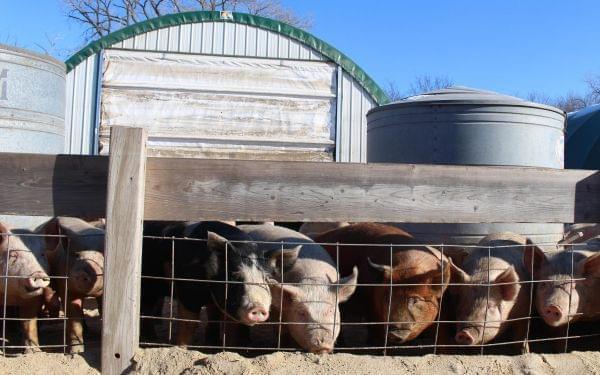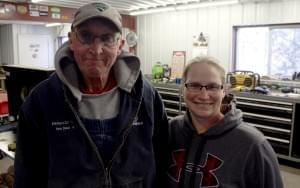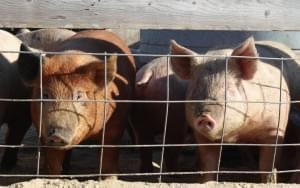Credit Crunch Puts Some Farmers In Tight Spot Ahead of Spring Planting Season

Hogs find the sunshine on a cold January day in eastern Nebraska. In addition to pigs, the Delaney family raises cattle and sheep and grows corn, soybeans and hay. Grant Gerlock/Harvest Public Media
In winter, farmers across the U.S. visit their banks to learn whether they have credit for the next growing season, relying on that borrowed money to buy seed, fertilizer and chemicals.
But prices for corn, soybeans and wheat are low enough that some producers have had a hard time turning a profit, and financial analysts expect some farmers will hear bad news: Their credit has run out.
That’s what happened to the Delaneys, a family now trying to save their farm near Fremont, in eastern Nebraska.
The headquarters of the farm is an office inside a steel machine shed, where they repair broken-down tractors and equipment. Several years ago, when crop prices surged, the family gathered in this office and planned to grow the farm.
“More acres, more income. That’s the old philosophy,” said Tom Delaney, who runs the farm with his son, Tim, and daughter-in-law, Jody. They built it up to 2,500 acres — more land than most farms in the area — but when grain prices fell it was more than they could afford.

Tom Delaney farms near Fremont, Nebraska, with his daughter-in-law Jody (right) and son, Tim. Their bank, Farm Credit Services, will no longer offer them credit, leaving them scrambling to avoid foreclosure. "We don't know if we'll be here a month from now," Tom Delaney says.
In that same office nearly two years ago, Delaney says two lenders from their bank, Farm Credit Services, told them their farm was in a financial tailspin. The lenders “basically said we’re not going to back you up anymore and you need to sell out,” Delaney said.
The family couldn’t cut costs enough to convince the bank that they could pay back their $1.8 million debt.
Delaney says it felt like the end of the world. “We don’t know what the outcome of tomorrow is going to be,” he says with a frustrated tone. “We don’t know if we’ll be here a month from now.”
The vast majority of farms in the U.S. are not in as much financial trouble as the Delaneys. Farms that own their land tend to fare better because they don’t have to pay rent, and the value of the land gives them more borrowing power.
But the U.S. Department of Agriculture estimates about 12 percent of crop farms are highly leveraged — including new farms that haven’t built up assets or farms that grew too fast, like the Delaneys. That level of debt makes farms vulnerable as banks tighten producers’ credit.
Help on the way?
While the financial pain may be limited across the industry, every day is a crisis for the individual farms that lose their loans.
“It’s hard for those from a generational farm, feeling a sense that they’re the generation that could be losing the farm,” according to Michelle Soll, the director of the Nebraska Rural Response Hotline. It was established during the 1980s farm crisis to provide financial and legal advice and family counseling. Surrounding states offer similar services, such as Iowa Concern or the Kansas Rural Family Helpline.
Jody Delaney says her days have been consumed with efforts to fight off foreclosure and save both the farm and her family.
“There were a couple months when they called our loans that we had nothing,” she says. “If it wasn’t for some odd jobs, our family would have gone hungry and our animals would have, too.”
She also says she and her husband considered divorce “because we were fighting, because of the stress.”
“We’re all fighting for the same cause, to save the family farm, to save the family business.”
Soll says she advises farmers to be detailed and honest about their business plans when meeting with their lenders because refinancing with a new bank can be a tall task. When one bank says no, it’s not as easy as going to the next one.
“Most of these banks have been bought out by larger banks,” Soll said. “They just have a guideline and that’s your guideline and that’s it.”
The Farm Service Agency, which is part of the U.S. Department of Agriculture, can help producers secure credit by lending money directly or by guaranteeing bank loans. In 2017, the FSA issued $6 billion in new credit, and is currently working with more than 120,000 farm families. But there are limits: Direct microloans go up to just $50,000, and loan guarantees top out at $1.4 million.
That may seem like a lot of money, but it doesn’t go as far as it used to. Just one acre of cropland in the U.S. is worth $4,000 on average. And those big loans are leaving farmers with fewer options.
“When debt rises to that point, it does limit your pool of lenders,” Nebraska Farm Business, Inc. financial analyst Tina Barrett says. “It might be time to liquidate some assets, pulling that debt down, so that you are more marketable to different banks.”
Scaling back and up

The hogs raised by the Delaney's eat non-GMO grain, and will be sold for a premium price to a company that supplies pork to Whole Foods.
The Delaneys have downsized to about 500 acres, switched to growing non-GMO crops (which bring in more money than traditional crops) and revamped their farm since losing their loan. There’s now a hog pen, where pink and red Berkshire hogs root around the dirt and make a clatter as they lift and drop the flaps on their feeder bins.
These animals are another part of the Delaneys’ rebuild, with a plan to raise about 2,000 hogs a year for Heritage Foods, which supplies upscale grocer Whole Foods.
Jody Delaney says her father-in-law was not on board with the idea at first, “but now I don’t think he’d change it for the world. He’s with these hogs every day, sometimes five or six times a day, checking on them to make sure they’ve got food, water, heat.”
Tom Delaney shrugs and reaches into the pen to pat a pig on the back. “If that’s what it takes to pay the bills it’s what we’re gonna do,” he says.
The farm is still in debt and the bank could foreclose on it, but it is earning a profit again. The Delaneys say this is their chance to save the family farm — if they can find a bank that feels the same way.
Follow Grant on Twitter: @ggerlock
Links
- Farm, Food, Forestry And More On The Table In The Next Federal Farm Bill
- Farmers On Trump’s Speech; Caterpillar’s Overseas Tax Profits; St. Louis-Chicago Amtrak; Snowy Owls
- Sweeping Changes To U.S. Tax Code A Mixed Bag For Farmers, Rural Hospitals
- Healthcare Sign-Up Deadline; Sexual Assault In Prisons; Climate Change and Farming; Winter Pets
- Farm Income Rising, But Not Everywhere
- Cover Crops Can Help The Environment, But Can Farmers Afford To Plant Them?

